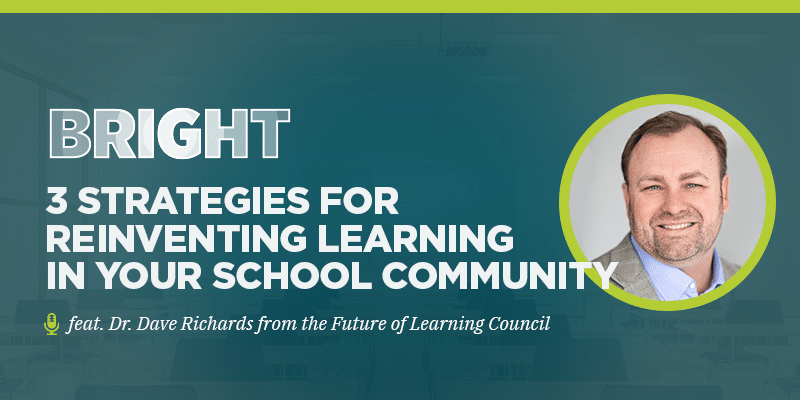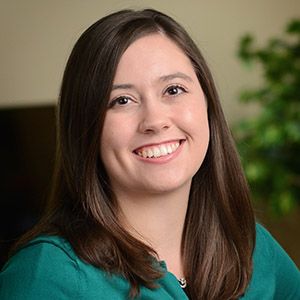Or listen on Apple, Spotify, Google, or another platform. Alternatively, you can read along with the transcript.
What could K-12 education look like if we let go of our assumptions about what school is supposed to be and instead focused exclusively on designing learning experiences around what’s best for kids?
In this episode of the BRIGHT podcast, I chat with Dr. Dave Richards, an executive learning strategist for Michigan Virtual, former superintendent of Fraser Public Schools, and one of the founding members of the Future of Learning Council, a group of Michigan school leaders dedicated to redefining learning to better meet the needs of our students.
Together, we dive into Dave’s:
- Personal story of how school transformed his life as someone born into extreme poverty
- Vision for what learning can be at its finest, and
- Top three strategies for reinventing learning in your school community.
Here’s a sneak peek at our conversation:
You can listen to my conversation with Dave using the audio player above or by subscribing to the BRIGHT podcast in your app-of-choice (find us on Apple, Spotify, Google, and more) or by reading along with the transcript.
Of course, we understand that educators are busier than ever. If you don’t have time to listen to Dave’s full episode (which offers the fuller effect of his wisdom, energy, and examples), you can still benefit from a glimpse at his top three tips for reinventing learning in your school community below!
3 strategies for reinventing learning in your school community
- If you lead, you must read.
As a school leader, it’s imperative that you stay current and constantly be scanning the horizon to get a pulse on what’s coming. Everyone in your organization relies on you to cast the vision for the future. Figure out what you need to know and who you need to talk with to make your vision possible, then build your professional network accordingly.
- Create a healthy sense of urgency.
You can create a healthy sense of urgency as a leader without making people feel like you’re going to dismantle the current system. Foster a culture of continuous improvement and set the expectation that when it comes to the education of our children, we aren’t going to settle for “good enough.” Make this conversation a positive one. Celebrate current successes and cast a vision for the future. Don’t just add more to someone’s plate. Ask for their input and give them permission to take things off their plate. Whether they’re a building principal, a school bus driver, or a custodian, it’s vital that everyone in your district understands and can have productive conversations about your shared vision and mission for student learning.
- Hire amazing people.
You can’t do this alone, and you don’t want everyone to be just like you. It’s crucial to hire amazing people and then empower them. Once everyone knows that they can drive the vision, they light up. If you have the right people in place and give them autonomy, they’ll start looking for new and improved ways to bring your shared vision to life. Then, you, as a leader, can then take on the role of supporting them and getting out of their way.
My favorite quotes from this episode
“We’re going to set you free. You demonstrate mastery, you demonstrate proficiency, and we’re going to let you move at your pace. If you can move faster, let’s make that happen. If you need more time, we need to create space for you to have that as well. And if you’re gifted and creative, how can you express your learning in a way that maybe isn’t what I’m used to?”
“It’s incredible. When kids begin to co-author their learning, you see the level of engagement just go through the roof. And that’s because they’re like, ‘Wait, you’re saying that I have a voice? That I can participate, know what I know, express what I don’t know, and then lay out a plan for me? How could I not want to be a part of that?’”
“The flexibility in the mobility piece is being embraced everywhere, and schools are realizing that if they want to thrive, they need figure out how to design for mobility and bring flexibility around schedules and location.”
“I’m not saying that our schools are broken. But I do believe that there’s an opportunity right now to really, truly design learning rather than creating a structure of school.”
“When you focus on learning… the lens isn’t about the bell schedule. It isn’t about compliance. It’s not about the structure of what we’ve always done. It’s not about trying to fit everything inside this box. When you focus on learning, there is no box. There is a creative canvas from which you can design.”
Related resources
- Learn more: The Future of Learning Council
- Learn more: William Bridges’ Transition Model
- Read: Inevitable: Mass Customized Learning by Charles Schwahn & Beatrice McGarvey
- Get it in your inbox: Getting Smart
- Get it in your inbox: Christensen Institute
- Get it in your inbox: KnowledgeWorks
- Listen or read: Michael Fullan sees global momentum for deep learning
- Listen: What’s best for kids?

